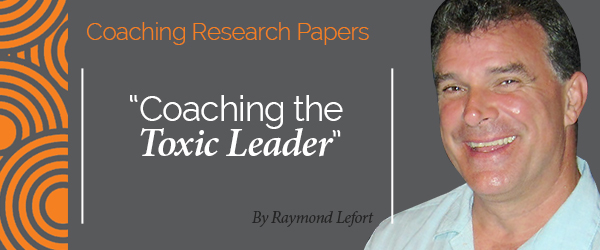
Research Paper By Raymond Lefort
(Executive Coach, CANADA)
Article Title:
Coaching the Toxic Leader, Four pathologies that can hobble an executive and bring misery to the workplace-and what to do about them. By Manfred F.R Kets de Vries, April 2014, Harvard Business Review
Article Summary
The article draws attention to the role senior executives have in creating a work environment where employees feel satisfied and make a contribution – or one where the environment can be dysfunctional and employees are unhappy. The impact an executive can have depends on his or her mental state, where good mental state leads generally to appropriate corporate rules and unhealthy mental state generally leads to a more dysfunctional organization. The author describes four pathologies that he has encountered in his coaching practice: the narcissist, the manic –depressive, the passive-aggressive and the emotionally disconnected. Drawing from examples in his practice, the author describes each pathology and describes possible behaviours that are often associated with the pathology and the approach used to coach an executive who is afflicted by the pathology. A summary of each is provided below.
| Pathology Type | Recognizing the Condition |
Coaching Approach |
Narcissist |
|
|
Manic-Depressive |
|
|
Passive-Aggressive |
|
|
Emotionally Disconnected |
|
The author also explores in the article the differences between coaching and therapy. He describes where various perspectives on this topic “draw the line”- one distinction being that coaching is based in the conscious and therapy on the unconscious. On this point he concludes
But it’s my conviction that therapist can benefit from knowing more about the organizational world, and coaches without training in psychology would do well to acquire its basics.[1]
Review
This article is interesting from many perspectives. First, looking at my personal career and work experience it was interesting to be able to gain a greater understanding of leadership impact. Having worked in organizations where sometimes the leadership was wonderful and sometimes more toxic, I found it useful to gain a better understand of various predominant pathologies in leadership, their impact and the coaching approach to use in each.
Since the beginning of my ICA journey I have wondered about the marriage of consulting and coaching. Though I have not reached a “conclusion” for myself on this topic I am developing a sense that, as in many disciplines, the more tools at our disposal the greater the effectiveness of our interventions with our clients can be. The author of the article brings an interesting new perspective. While ICA advocates a clear segregation of therapy versus coaching, the author advocates a marriage of the two disciplines as appropriate. Given the authors wide background in Economics, Management, Psychoanalysis this bias was not surprising to me. In the end, I believe its about having the proper training-that is don’t try to be a coach or a therapist without the proper training.
Take away from the article:
[1] Kets de Vries, Manfred, F.R. (April 2014). Coaching the Toxic Leader. Harvard Business Review, Page 9.